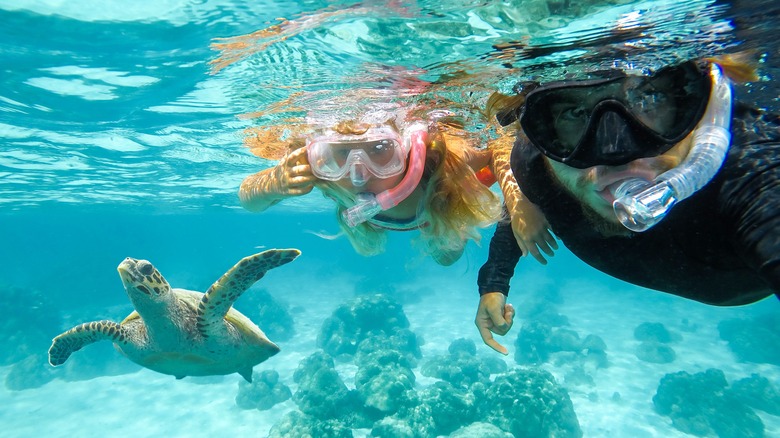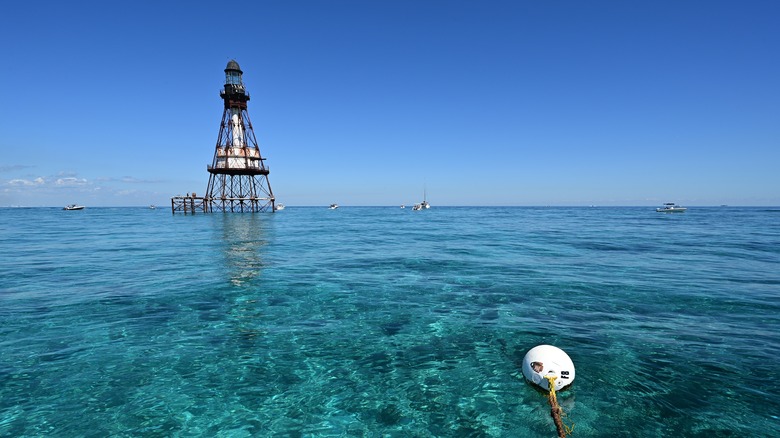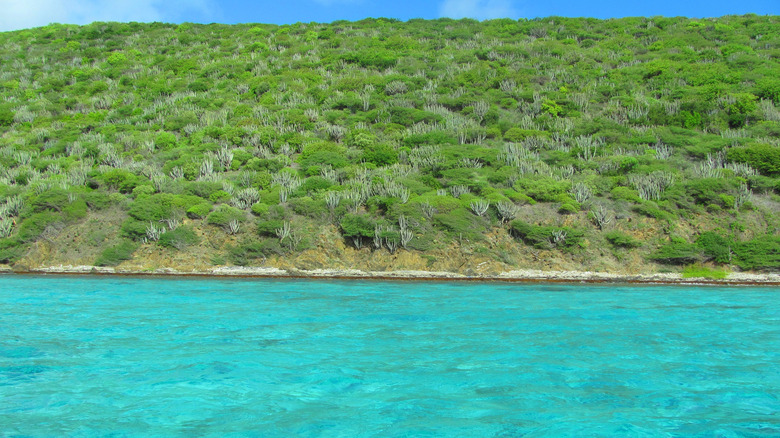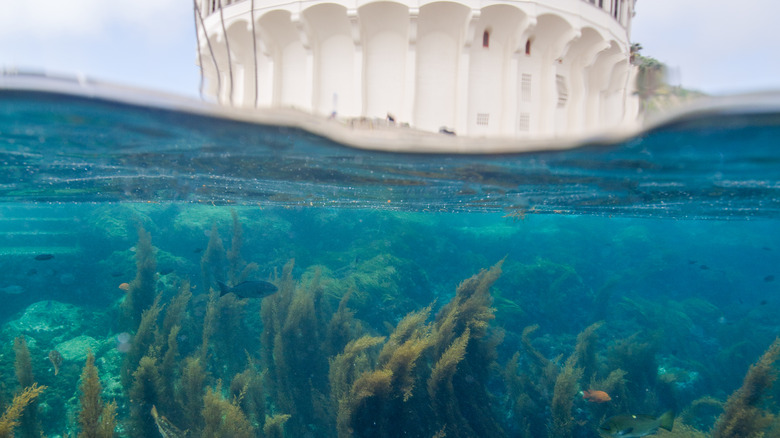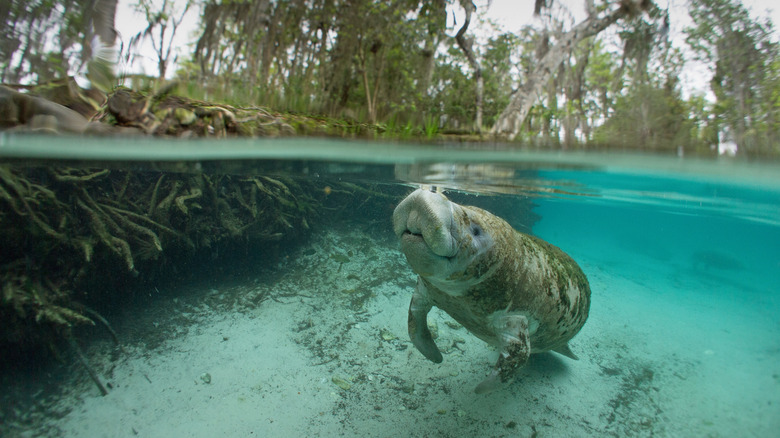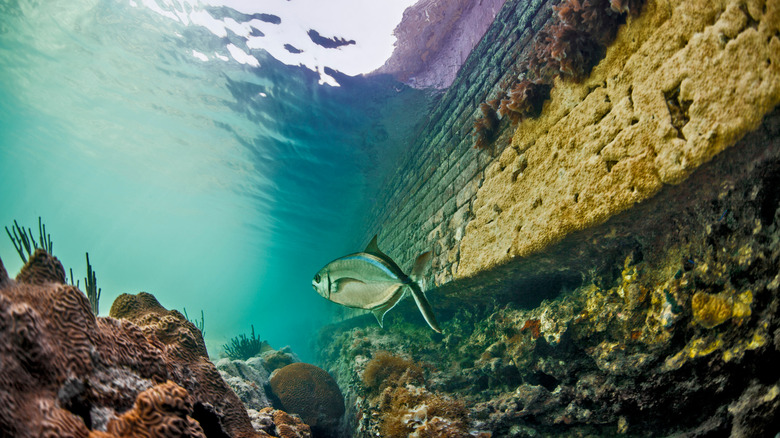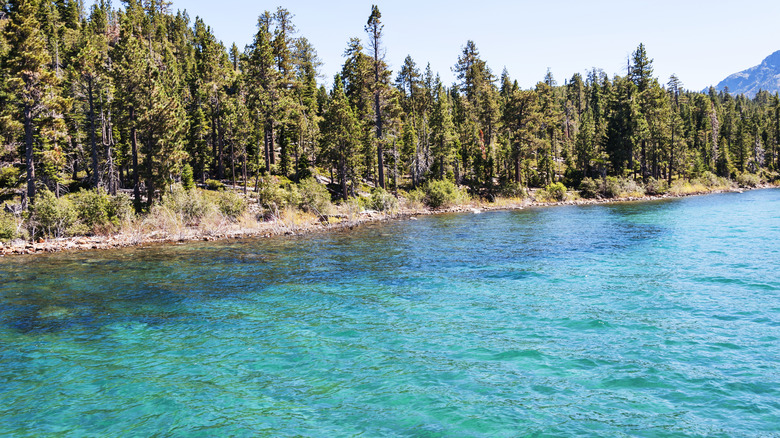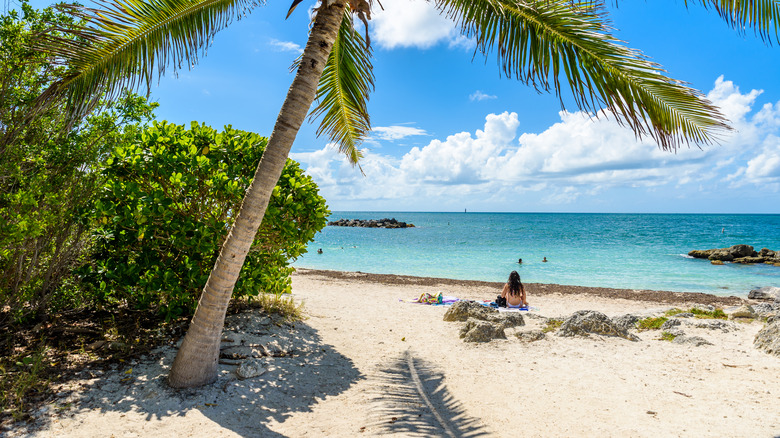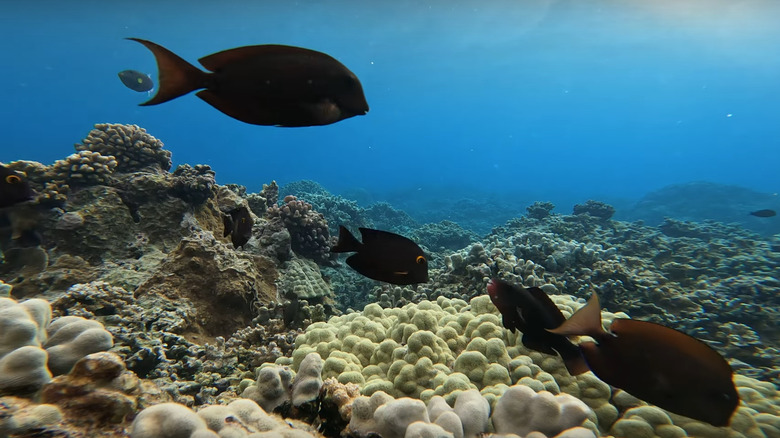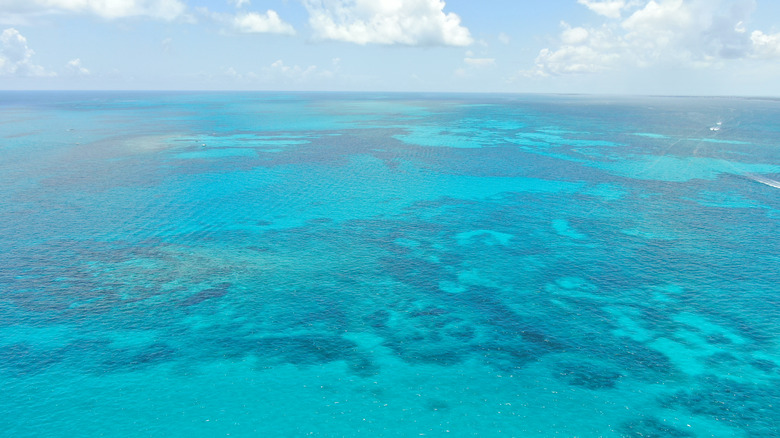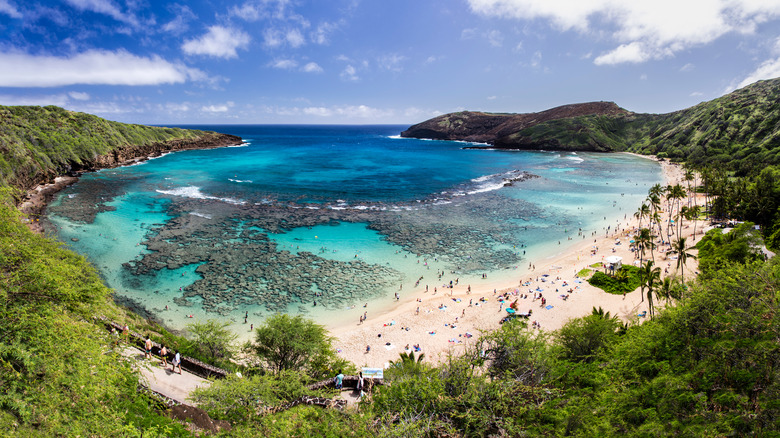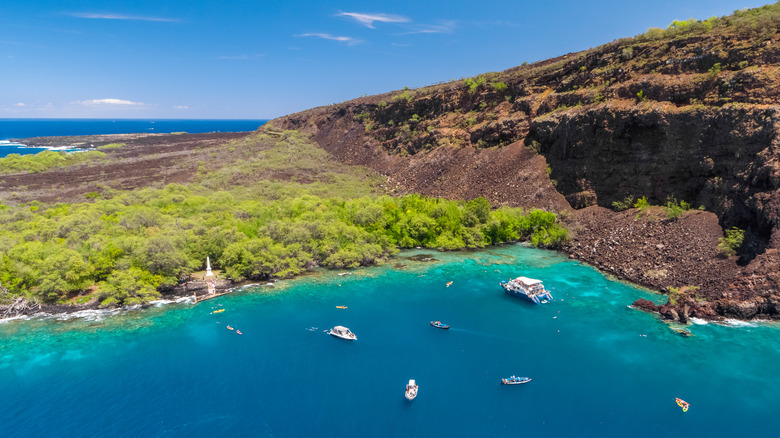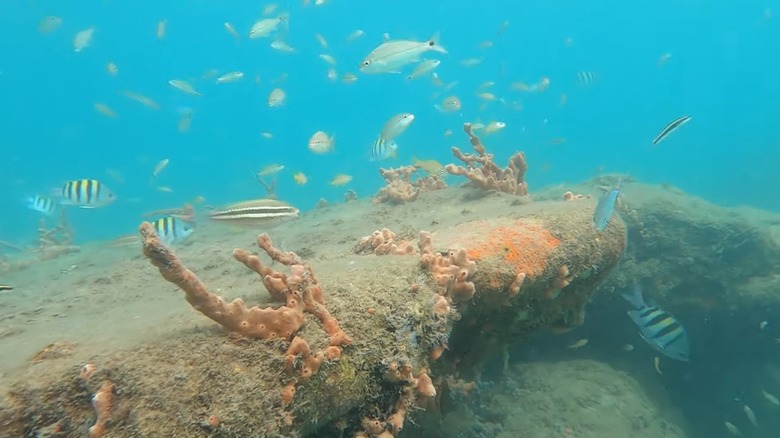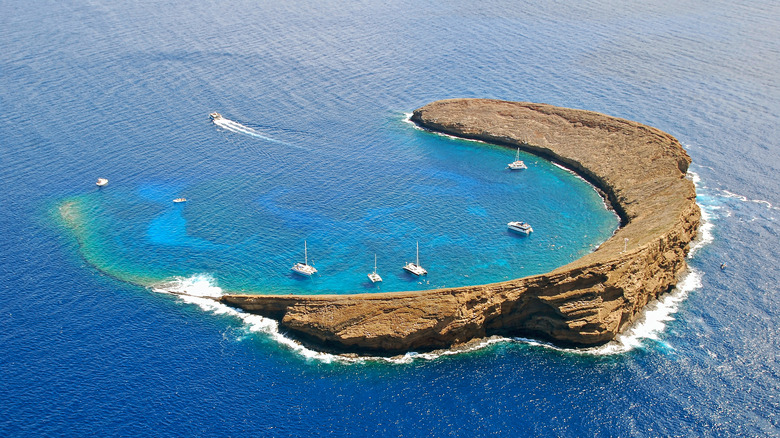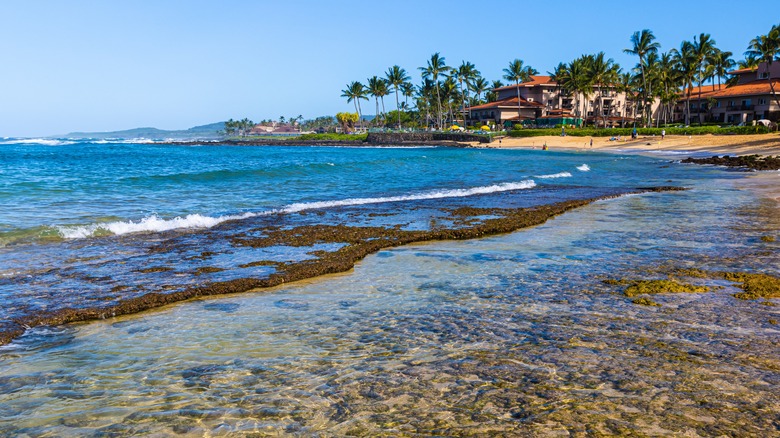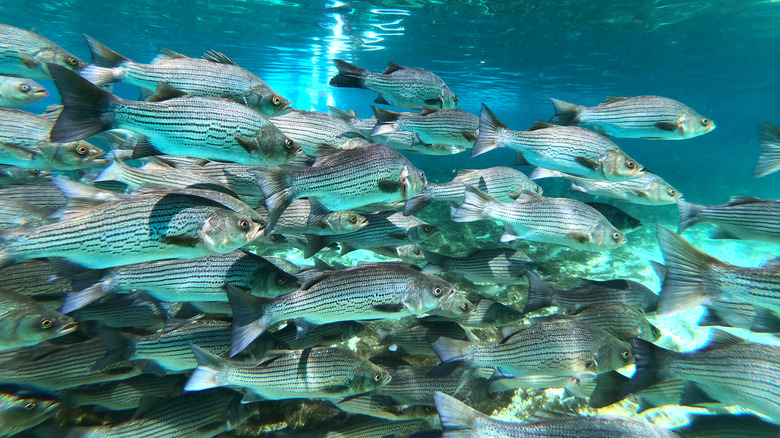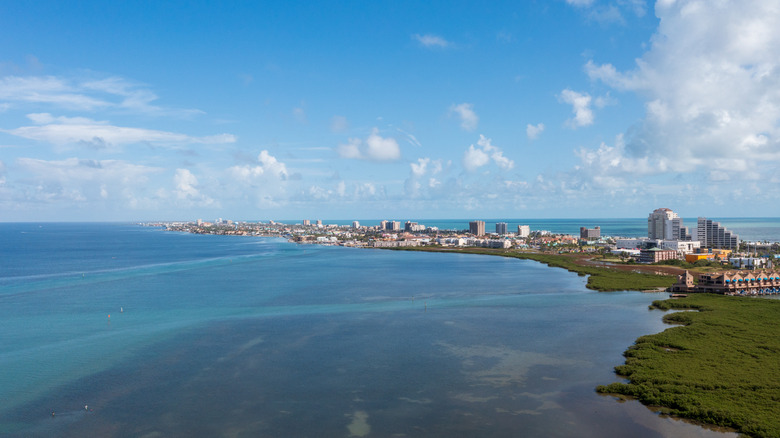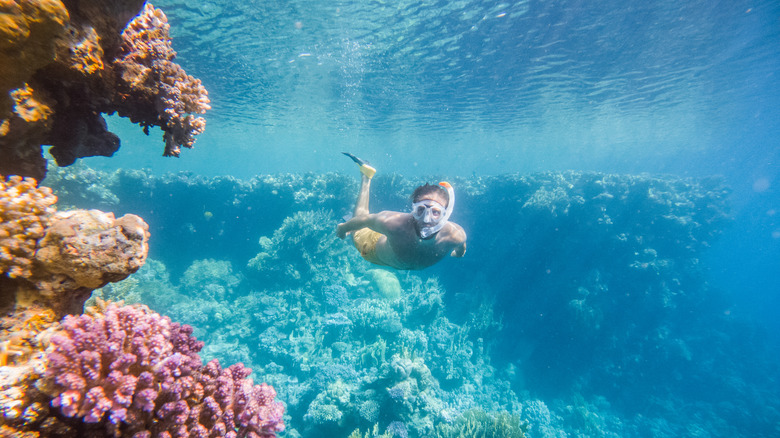16 Most Stunning Snorkeling Destinations In The US, According To Travelers
As any swimmer, snorkeler, diver, or even casual observer of a nature documentary knows, a whole other world exists under the water. There, life beats to a different drum, and humans are just visitors. Exploring the shallows can be a thrilling adventure, like traveling to another planet. However, while diving allows for deep explorations beneath the surface, it also comes with stringent time constraints. Snorkeling, on the other hand, is a much less complex endeavor.
At the best places to snorkel, you can spend hours gazing at coral, looking for fish, or hoping to spy a turtle without checking depth gauges or keeping an eye on your air levels. Thankfully, many fantastic snorkeling locations exist in places like the South Pacific. However, you don't need a passport to take in these wonders.
By scouring travel blogs, tourism sites, and review platforms, we've highlighted spots in the U.S. worth snorkeling. While our selections are not entirely based on personal experience — we'll explain our methodology more at the end — the majority come from travelers, snorkelers, and visitors who have left reviews and written blog posts about these stunning destinations.
Biscayne National Park - Florida
Biscayne National Park, one of the best national parks on islands and beaches, is situated south of Miami and has plenty to keep visitors busy. Travelers will encounter opportunities to take a boat trip to a remote key and see a lighthouse, sail on the open sea, and even help with a beach clean up (for the more altruistic individuals). Visitors praise the stunning scenery, including lots of coral, sea life, and shipwrecks that form a Maritime Heritage Trail. "The sea fans, finger and brain coral and fish were the most spectacular I've ever seen," one traveler said on Tripadvisor.
Travelers can book snorkel excursions through the Biscayne National Park Institute, a non-profit that strives to increase the enjoyment of the destination. The 3.5-hour trip, which departs two times daily, sets out for the bay aboard a powerboat. In the water, snorkelers will see coral and sea life in the Atlantic or nurseries of fish in the mangroves. Six shipwrecks populate the maritime trail (the earliest sank in 1878), and the base of the Fowey Rocks Lighthouse was recently added to the list of stops.
Buck Island Reef National Monument - St. Croix
One of the U.S. Virgin Islands, St. Croix, has some sensational beaches, including those on Buck Island. But more than just sizzling sand, Buck Island Reef National Monument is a snorkeling superstar. "For visitors to St Croix in the US Virgin Islands, snorkeling at Buck Island Reef National Monument is a must," wrote The Thorough Tripper on his blog. "Seeing [the coral reef] in person was awe-inspiring. Walls of coral, long branches of ellkhorn coral rising from the ocean floor, mounds of coral that looked like big brains, and then all the different kinds of tropical fish."
This national treasure has grottos that visitors can snorkel along as part of an underwater trail. Since guides cap the number of participants to six at a time to ensure everyone enjoys the trail, there is never overcrowding. Signs along the way describe the sights snorkelers will encounter in the park, which sits 5 miles northeast of St. Croix. Among the highlights are the healthy sections of elkhorn, star, and brain coral. In terms of fish and other sea life, there is no shortage. Water babies will see swimmers of many shapes and sizes, from green sea turtles and eagle rays to large gatherings of parrot fish, blue tangs, and maybe even some skittish reef sharks.
Santa Catalina Island - California
An amazing isle off the coast of the mainland U.S. between Los Angeles and San Diego, Santa Catalina Island (people often drop the "Santa") serves as a dependably gratifying snorkeling destination. Reviewers on Yelp praise Catalina Island for its "crystal clear" waters and the abundance of wildlife, including dolphins. You can expect breathtakingly blue water in the surrounding area, though it's not always warm, and the winter months often see snorkelers and divers taking to the ocean donning full wetsuits. There are no bad spots to snorkel, though some sections, such as around West End and Long Point, can have stronger currents to contend with.
Casino Point Dive Park and Descanso Beach are among the top locations where travelers might see garibaldi, giant sea bass, halibut, and possibly harbor seals. Some of the most ideal snorkeling conditions are found in the waters of Lover's Cove State Marine Conservation Area. Near the town of Avalon, it has dense, mesmerizing kelp forests and inhabitants such as moray eels and horn sharks.
Crystal River - Florida
On Florida's Gulf Coast side, Crystal River is a low-key realm of lakes and rivers fed by natural springs. It's also one of the few places in the world where visitors can swim and snorkel with manatees, and doing so is listed on Tripadvisor as one of the top outdoor activities in Crystal River. A languid, lovable mammal that looks like a cross between a walrus and a cow, manatees are darn cute, even if they can grow to 14 feet long and weigh over a ton. From personal experience at Crystal River, when looking under the water at these gorgeous creatures, you feel this warm glow. You just want to give them a big hug.
Time in the water with them is always part of a tour to control numbers and ensure that the manatees aren't harassed or stressed. The excursion takes place within a manatee refuge, and participants might find the manatees approaching them with a sense of curiosity. While the temptation to pet or touch them can be overwhelming, visitors should not do either; these wild animals should be treated with the utmost respect and given space. In general, it's crucial that you don't touch anything while snorkeling to avoid disrupting the local ecosystem.
Dry Tortugas National Park - Florida
Located nearly 70 miles from Key West, the remote Dry Tortugas National Park is an exotic escape close to home and a snorkeler's dream. It covers about 100 square miles of the region, but less than 1% is land. And yet, there is incredible history there, with the hexagonal Fort Jefferson — a beautifully realized piece of architecture that once served a very practical purpose. The water is, for many, the biggest draw, and there are many places to snorkel, with much to see. "If you swim along the moat wall, you'll see tons of coral, colorful fish, and perhaps an octopus," wrote the Quirky Travel Guy in a blog post. "For those new to snorkeling like me, this is a fantastic place to try it out since there's such a vibrant underwater world going on."
Thanks to the park's location, with the Gulf current flowing close by, the sea life numbers seem to explode. Among the great places for snorkeling are around the pilings of old piers built by the U.S. Navy in the late 19th century, where grouper and barracudas wander. For a real adventure, visitors can snorkel along the moat wall at night, with squid and octopi serving as some of the nocturnal highlights.
Emerald Bay - California
While the winter of 2024 dumped many feet of snow on the shores of Lake Tahoe, the body of water remains a prime summer destination. Part of that has to do with the gorgeous natural surroundings, with forests and mountains all around, but it's also because of the water. Anyone who has seen Lake Tahoe will remember the extraordinary clarity of the liquid layer — some parts are so clear, it's as if the onlooker is peering through glass to the bottom of the lake.
Emerald Bay is an inlet southwest of Lake Tahoe and sits within a state park. It is notable for an underwater heritage trail. Launched in 2018, it was the state's first maritime underwater heritage trail, with several sunken wrecks sitting on the lake bed. Some are better suited to exploration by divers, but others, like the Barge Dive Site, are perfect for visitors with a snorkel. In fact, LakeTahoe.com lists Emerald Bay as one of its top places to snorkel, with "incredible" views and endless fish sightings.
Fort Zachary Taylor State Park - Florida
The westernmost point of Key West, which is shaped a little like a Moorish idol (complete with the trailing dorsal fin), Fort Zachary Taylor State Park has plenty of coral offshore. Visitors descend on Fort Zachary to fish off the jetty, maybe to catch something to grill for dinner that night, while others rattle along the paths on their bikes. The fort is a fascinating site — a National Historic Landmark built during the Civil War and stocked with powerful cannons.
Many people find the beach hard to resist, especially at sunset when the sun drops at the point where the Atlantic and Gulf of Mexico meet. Off the beach, snorkeling is said to be exquisite, with soft and hard coral and lots of underwater life, from snapper and lobster to parrot fish. Visitors on Tripadvisor praise this snorkeling destination for its clear, warm water, wildlife spottings, and "absolutely spectacular" views. Wear water shoes, as the beach is made of coral and can be hard on bare feet.
Molokai - Hawaii
The fifth-biggest island in Hawaii, Molokai sits between Maui and Oahu. It might not have the name recognition of the latter two, but it does stand out for many other reasons. This island is home to some of the most striking and tallest sea cliffs in the world, and off Molokai's southern edge, a long fringing reef unfurls. It extends for a substantial length, almost 30 miles in all, and teems with finger coral and tons of fish that live and feed along the reef.
While those are all excellent reasons to make a trip to the reef, what makes the formation even more remarkable is the chance to see local wildlife. According to The Hawaii Vacation Guide — a blog run by ex-Hawaiian locals — the fringing reef in Molokai is one of the best places to snorkel in Hawaii. "You will find vibrantly colored reef fish, Hawaiian green sea turtles, and you might be so lucky to see manta rays that live in the area."
John Pennekamp Coral Reef State Park - Florida
Hugging the southern part of Key Largo, a good stop on a Florida road trip, John Pennekamp Coral Reef State Park has exceptional marine life. Distinguished as the country's first underwater park, it covers an area of 70 nautical square miles, a vast, majestic realm beneath the waves. Tourists can see the aquatic riches on a kayak or a glass-bottom vessel, but diving and snorkeling are better alternatives for a more intimate connection to marine life.
Even if many visitors head straight for the coral reefs, other marine habitats are worth exploring, according to personal experience. The sections of mangrove and seagrass are also full of life, and since they are sheltered, they present smart options on windy days. You'll spot many juvenile fish, orange sea stars, sea slugs, and young lobsters. This park is also the site of the famous and often photographed underwater bronze Christ of the Abyss statue; don't miss it.
Hanauma Bay Nature Preserve - Hawaii
Reservations are required for entry to Hanauma Bay Nature Preserve, a popular snorkeling site near Honolulu, and the park is closed for two days every week: Mondays and Tuesdays. Even when it's open, entry cuts off around lunchtime, and visitors must leave by 4 p.m. All this has helped the park maintain a balance between appeasing tourists and staying in peak condition. It's a highly-rated spot, as showcased in the over 10,000 five-star reviews on Tripadvisor. "The bay's pristine waters and vibrant coral reefs provided an unforgettable snorkeling experience," one reviewer raves. "Swimming alongside colorful fish and encountering the diverse marine life was a true adventure."
Visitors could easily spend hours exploring the various sections of Hanauma Bay Nature Preserve, from the lagoons and channels to the outer reef, where beginners might struggle to snorkel safely. Wherever they go, travelers will spot marine life, including vibrant corals, tropical fish (there are 450 types of fish in the bay), crabs, eels, and octopi. Also, keep your eyes peeled for the occasional green sea turtle that drops by.
Kealakekua Bay - Hawaii
On the west coast of the Big Island, Kealakekua Bay is also known for its monument to Captain James Cook. The English sailor and explorer was the first European to discover Hawaii, landing on the islands in 1778. Whether you stop at the monument is up to you, but making time to explore the bay waters is a must. The waters are protected, sitting in the Kealakekua Bay Marine Life Conservation District, where fishing is prohibited so sea creatures can flourish.
Visitors can expect excellent-looking reefs, according to Big Island Guide, with "flourishing coral and marine life abundant in every direction." The coast is indented and jagged, and currents can be hard to read, so snorkelers should proceed with caution. Expect to see lots of fish, green turtles, and maybe even the occasional dolphin, but don't venture far from the shoreline.
Phil Foster Memorial Park - Florida
Under a bridge that connects the Florida mainland to Singer Island might not seem like a fabulous place for a snorkel excursion, but don't judge a book by its cover. The Phil Foster Memorial Park sits by an inland waterway with abundant marine life, and to take advantage of this rich environment, a snorkel trail was launched here. Using giant boulders made of limestone and artificial reef structures constructed from prefabricated materials (the whole project required 600 tons of rock to complete), the 2-acre site sits in a patch of shallow water.
Depths never go above 10 feet, so kids can easily navigate the snorkel trail, though they should always be supervised, with currents sometimes swift and sudden. Snorkelers can marvel at some surprising sights on a sortie around the park, including starfish, spotted rays, squid, and octopi. There are even sharks — rock sculptures of them, that is (and the occasional real deal).
Molokini Crater - Hawaii
This crater rim ridge, shaped like a crescent moon, seems to appear from the water. Situated about 3 miles from the southwestern shore of Maui, the island is the remnant of an old sunken volcano. The uppermost ridges of Molokini Crater soar more than 150 feet above the sea, rising steeply from the Pacific. The snorkeling at this remote site, which can only be accessed by boat, is reportedly exceptional, according to visitors on Tripadvisor. "We saw 5 huge sea turtles very close up; it was a once in the lifetime experience," one said.
Snorkelers will be spoiled for choice, with more than 250 species of fish in the water. Yellow tang, parrot fish, Moorish idols, rays, reef sharks, and moray eels are just some of the creatures waiting to be explored. Thanks to the lay of the land, the water is often very calm. Visit during the winter months, and you might even see whales.
Poipu Beach Park - Hawaii
This beach, with dual personalities on the south coast of Kauai, consistently has good snorkeling, as reported by the Snorkeling Report. The eastern side of Poipu is more protected, where the lifeguard is stationed, and is popular with families with young kids who enjoy the calm water. In the western part, the water is also calm, but the snorkeling is much better. Slide into the ocean, and there is a good chance you'll see parrot fish, flounder, butterfly fish, and devil scorpion fish.
Visitors will also have the opportunity to encounter "honu" (green sea turtles), either there or at the neighboring Brennecke's Beach. During the winter, when large swells buffet the island's north, the beaches are said to be lovely and tranquil, making a snorkel excursion an episode of pure joy. This is even true at Brennecke's Beach, which usually draws boarders for its fine, rolling barrels.
Silver Glen Springs - Florida
An inland waterway near Lake George and between Jacksonville and Orlando, this freshwater spot in Florida isn't huge, but it certainly packs in plenty to see. Located in Ocala National Forest, the snorkeling area is a spring-fed pool with water that is so clear it could stand in for a giant bathtub. In fact, it's "snorkeling perfection," a visitor on Tripadvisor said. Since it's also warm, hovering in the low 70s year-round, it's always a joy to enter.
The pool is less than 200 feet across, and since boats aren't allowed, there is never any churn, surf, or stirring of sediment. With depths in many parts less than 5 feet, Silver Glen Springs is a perfect spot for kids just starting their snorkeling journey. Visitors can see mullets, sunfish, the occasional turtles, and huge schools of striped bass in the water. Best of all, there is no salty aftertaste when you exit the water.
Laguna Madre Estuary - Texas
The Laguna Madre Marine Estuary is a fascinating body of water. Sandwiched between the Texas mainland and barrier islands and reaching down as far as the border with Mexico, it's a lagoon of hyper-salinity — it has a higher salt content than the sea — only one of six in the world. It's also a rich, varied environment, with wetlands, marshes, bays, and important birding areas.
There is much to see for snorkelers, with the shallow waters home to ⅘ of the state's seagrass areas. "Laguna Madre is a beautiful and protected lagoon with no reefs, so you can snorkel everywhere and see the marine life from the area," wrote the seasoned travelers behind Worldwide Travel Tips, who claim Laguna Madre is the best spot to snorkel in all of South Padre Island.
This ecosystem contains a wealth of fish, including flounder, redfish, and spotted sea trout. Travelers can encounter many of them during a snorkel trip to the estuary. The waters are usually less than six feet deep, making them a great testing ground for young kids or adults with little snorkeling experience. Guided trips often leave from South Padre Island, the main tourism nexus in the region.
Methodology
We haven't had the privilege of snorkeling in every single body of water the U.S. has to offer — only two on this list, Crystal River and John Pennekamp Coral Reef State Park — so compiling the top snorkeling destinations was no easy task. But we've narrowed our choices down to these stunning 16 spots using information collected from the internet. Review sites like Tripadvisor, trusted blogs run by seasoned travelers, and official tourism board pages helped us assemble the picks outlined here.
Our personal experience with snorkeling, although limited, helped narrow our focus to what would be considered the most "stunning" locations. While warm water temperatures and a friendly snorkel guide contribute to a successful snorkel trip, a truly stunning one has all the makings of what you would see on your television screen during an episode of "Dive Detectives" — clear water with great visibility, colorful coral reefs or other breathtaking ecosystems, an abundance of fish, and diverse wildlife. According to our research, these places have it all.
